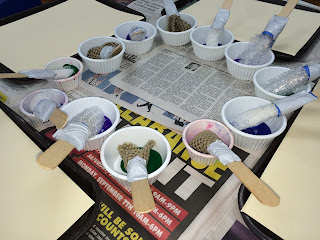A new material I’ve introduced to my two and
three-year old class is texture brushes. I’m sometimes skeptical of the art
activities that involve painting with different objects. Paint brushes are
designed the way they are for a reason, to be able to control the movement of
the painting tool to make marks on paper. If the goal is to make carefully
controlled or deliberate markings, paintbrushes or something similar are
perfect tools. But if the goal is to experiment with different ways of getting
paint onto paper, and to explore the physics of how texture, size, and movement
impact the painting process, then using a variety of materials is a great
scientific exploration.
I always consider these questions when choosing painting tools:
I always consider these questions when choosing painting tools:
Can children physically manipulate and control the
tool?
Is it sturdy enough to withstand pressure, bending,
and physical force?
Will it hold the right amount of paint for children to
be successful?
And, for children under 3: Is it clearly something that
should be used for painting?
This last question might seem contradictory, if the
purpose is to paint with objects not specifically intended for painting. But very
young children have trouble distinguishing between using the same object in
different contexts. A toddler might not understand that an apple dipped in
paint isn’t an apple for eating. And a two-year-old might not understand why they can dip the toy animals in paint today but not tomorrow, or why they can paint with toy animals but not with other toys they pull off the classroom shelves on their own.
There’s also the sensory component of painting.
Brushes have their own textures and tactile sensations, whether the brush is
moving across the palm of your hand, or you’re feeling the sensory input from
pushing the brush against paper. Different objects in paint each have their own
sensory and tactile components too.I decided to make my own texture brushes – each one was a different material taped to a large craft stick. I choose waterproof materials that could be washed and reused: heavy duty shelf liner, bubble wrap, and fabric from a mesh bath sponge. I cut a strip of fabric from each material, and taped it around the stick. First I used masking tape, but realized that wouldn’t be strong enough, so I added a layer of duct tape as well. Plastic spoons would also work as handles instead of craft sticks and would be more waterproof.
I made four sets, each with the three different brushes. I set up the activity as individual stations, each with three colors of paint and three different brushes.
The painting was much less deliberate and intentional
than brushes as the focus shifted to the physical properties of the materials:
how they felt, how they moved across the paper and across skin. I wouldn’t
think of this as an “art” activity as much as a “sensory” or “science” activity
that happened to use paint as the medium for exploration.







No comments:
Post a Comment